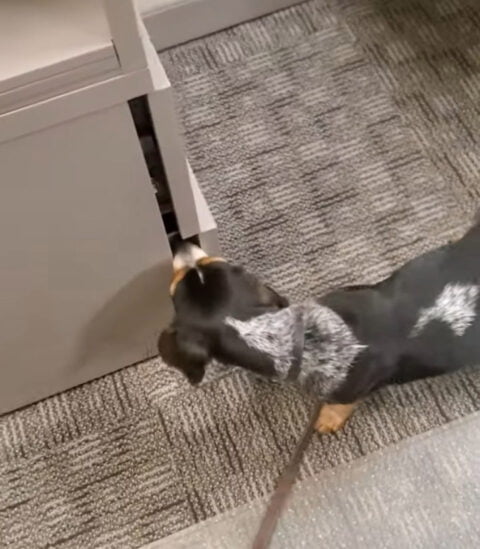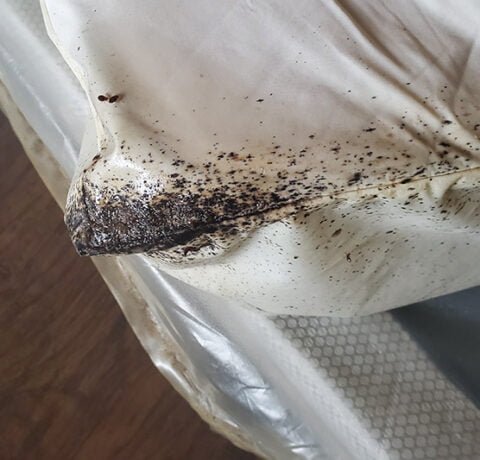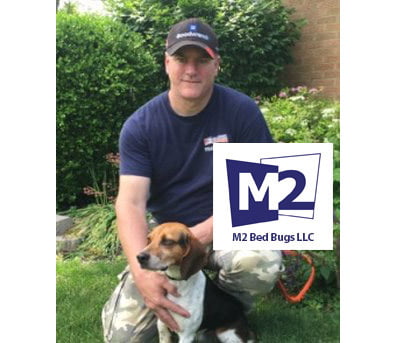Mike Posey from M2 Bed Bugs in Lancaster, OH first heard about Aprehend back in early 2018 during a presentation by Dr. Susan Jones from Ohio State University. At that time, he had 11 years experience in the industry and 5 years with his own business, and he was intrigued about a “greener” pesticide. Mike started to do some research in trade publications and on-line to learn more about Aprehend. Despite having a successful chemical protocol and some heat applications, Mike decided to use Aprehend exclusively for 6 months as a trial. The first thing he noticed is that customers were NOT calling back for re-treatments. He had to call them back and make sure things were ok, and he thought “wow, this is so impressive.” It allowed him to gain business in places where the customers “don’t like chemicals.” Since then, he has adopted Aprehend exclusively
for use with his K9 teams and 95% of his work comes from bed bug treatments. Mike’s most notable illustration of Aprehend’s power is with a long-term active infestation at a homeless shelter.
Local Homeless Shelter Needs Help
A local homeless shelter called Mike in 2021 after not getting results with ongoing bed bug infestations from a prior vendor. Active infestations were frequent and ongoing in many tenant apartments, and bed bugs were sighted daily in the office areas .The shelter wanted a provider that offered K9 inspections. Mike and Rosie the blue tick beagle found eggs and live bed bugs in a room that had been inspected and cleared by human eyes the day prior. Rosie found bed bugs in a closet door frame. 50% of the rooms had active infestations. Scamp found bugs in the office area (Figure 1). The initial inspection with K9s took about an hour.

Figure 1 Rosie inspecting the office areas.

Figure 2 Evidence of infestation during inspection in a tenant apartment.
Mike felt that Aprehend would be an attractive solution for treatment and long-term on-going protection when applied quarterly. The shelter is a 35,000 sq.ft. combination of 20 tenant apartments, 2 common areas, laundry, and an administrative space with offices and cubicles.
Prep Strategy
The main prep strategy in tenant apartments was to remove anything under the bed & pick up clothes from the floor and put them in totes. This was done so that the technicians could access the area and vacuum. As Mike says, “I don’t need you to be spotless, I just need you to have things in order.” In general, the goal is to leave items where they are whenever possible, because the bugs will be comfortable there and you don’t want to just shift the harborages to another location. In the offices, the only prep required was to place any papers on the desk or floor into totes with NUVAN® PROSTRIPS®.
Treatment Strategy
The initial treatment took 3 days to get through all the rooms and office space and adequately treat all surfaces.
Tenant apartments – Mattresses were encased, but no other products were used in conjunction with the Aprehend. Frames, boxsprings, and hotspots were treated with Aprehend. Monitors were placed in the apartments under bed frame legs.
Offices – Aprehend was applied around the baseboards, the sides of cabinets, under the chair seats, the underside of the desk perimeters, and pullout keyboard trays. Interestingly, the client made a switch to mesh chairs which provided less harborage sites compared to the upholstered fabric chairs that they had been using.
Check-In Room – Prior to M2, the shelter performed tenant check-in in the office area. Bed bug sightings occurred daily. Together with the staff, they converted a large storage closet into the check-in room. All preliminary paperwork and service set-up happens here. Belongings are placed in totes, not on the floor. Employees are extremely happy, because even if bed bugs come into the facility, they leave the check-in room infected with Aprehend. The sightings are next to nothing in the office, and the staff has peace of mind.
Results
After the initial treatment and establishing protocols, the numbers started to fall. A follow-up inspection with the dogs is done after 30 days, because due to the biology and behavior of bed bugs, after 2 weeks there still may be activity and it’s not enough time for all the bugs to be active and move across an Aprehend barrier. If the dog alerts, then the area is marked and the tech comes back to re-treat if necessary.
After working with this property on preventative treatments, there has been a complete turnaround in infestations. Now M2 goes back every month for K9 inspections and spot treats if there’s an alert in the room and/or hallway. There might be 1-2 apartments that have a bug or two, but that’s usually due to new tenants. The offices no longer have trouble, so the staff is extremely happy. The rooms are re-treated quarterly to add a fresh Aprehend layer and provide on-going protection.
Conclusion
Success at the homeless shelter—with both eradication and ongoing prevention—showcases Aprehend’s power and versatility, but the combination of K9 inspection and Aprehend is Mike’s go-to for all bed bug work. It’s efficient, profitable, and highly effective.
Mike says, “Many PMPs are still thinking old-school, using a ‘one-size-fits-all’ approach for bed bugs. Bagging clothes and spraying entire houses for 10 bugs on the couch—that’s not necessary. With Aprehend, we approach with a targeted strategy focusing on where there are bugs and physical evidence of where to treat rather than mass spraying of every surface.
With inflation, Aprehend is very cost effective because call-backs are reduced and I’m not making as many trips out on jobs. When you become efficient with it, knowing where to spray or not, you don’t have to spray as much, and with dogs there’s no guessing where the bugs are.”
Click here to watch a video of M2s K9 Turbo in action.
Click here to read more about Mike’s M2 Bed Bugs K9s.
Click here for print-friendly PDF of the case study.
If you’d like to cut prep and treatment time, increase margins, and reduce call backs, give us a call at 800-891-8610.


